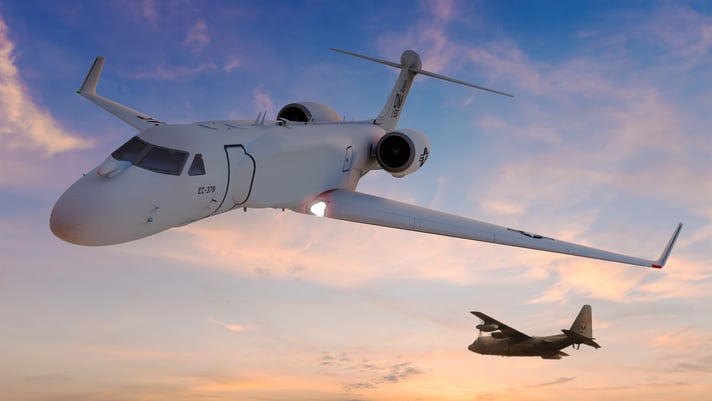
BAE Systems graphic of their new EC-37B Compass Call, with the current EC-130H model in the background.
WASHINGTON: The Air Force wants to revamp its electronic warfare (EW) force structure and move beyond platform-centric systems to software-based defensive and offensive capabilities that allow coordination across multiple platforms.
In a request for information (RFI) released yesterday by the Air Force Life Cycle Management Center, the service said it is looking to “assess industry capability to design, build, and demonstrate a rapidly configurable EW system to include both Electronic Attack (EA) and Electronic Support (ES) capabilities postured for responding to software-defined, highly agile 21st century EW enemy systems while still addressing all legacy threats.”
“The USAF future strategy for EW systems is for advanced, wideband EW systems incorporating a flexible architecture to enable multiple platform EW coordination for prosecuting diverse mission sets,” the RFI explains.
The idea is to move to a system-of-systems, rather than the myriad platform-centric EW systems the Air Force now operates. These include, among others, the Compass Call aircraft now being upgraded to be carried on a EC-37B jet by BAE Systems; the Eagle Passive/Active Warning and Survivability System (EPAWSS) EW suite for the F-15E (currently being upgraded by Boeing through 2021 under an on-again/off again program as cogently explained by colleague John Tirpak back in October); the ALQ-131 jamming pod; and the highly classified EW systems embedded in the F-35 Joint Strike Fighter.
“Current EW systems can and do work together, but many are federated and not integrated,” Glenn “Powder” Carlson, president elect of the Association of Old Crows (AOC), told Breaking D today. The AOC is the venerable industry organization that brings together EW operators and companies.
The RFI is one of the first industry solicitations since the Air Force announced in April 2019 an overhaul of its organizational structure for EW operations to to fight back against Russian and Chinese information warfare, and to enable multi-domain operations.
As Breaking D readers know, the reorganization consolidated the 24th Air Force, which provided the Air Force’s contribution to Cyber Command (CYBERCOM) and the 25 Air Force, which provided mobile integrated intelligence, surveillance and reconnaissance to all of the component commands, under a single commander. The new organization, called the 16th Air Force, is headquartered in San Antonio and is led by Lt. Gen. Timothy Haugh, who was confirmed in his new position by the Senate in late September. Haugh previously lead the 25th Air Force.
The changes were the result of two years of study by the EW Enterprise Capability Collaboration Team (ECCT, designed to make recommendations for how the Air Force can “ensure electromagnetic spectrum superiority” in the future, according to the Air Force. The team was led by Brig. Gen. David Gaedecke, director, Cyberspace Operations and Warfighter Communications, Office of the Deputy Chief of Staff for Intelligence, Surveillance, Reconnaissance and Cyber Effects Operations.
Meanwhile, at the insistence of Congress in the 2019 National Defense Authorization Act, the Pentagon has stood up an Electromagnetic Spectrum Operations Cross Functional Team led by Joint Chiefs Vice Chair Gen. John Hyten, that includes all four services; the Joint Staff; the Pentagon’s Chief Information Officer; the undersecretariats for acquisition, research, and intelligence; Cyber Command; and Strategic Command.
The planned prototype demonstration “will consist of 6 notion signals with 3 generic (unclassified) jamming techniques. The participants systems being demonstrated shall be able to correctly identify the threat and provide the correct jamming technique,” according to the RFI. It is tentatively slated to take place sometime in June, with industry responses to the RFI due on Feb. 28.
In particular, the Air Force is seeking capabilities based on open standards so it can modify or update the hardware and software to meet future requirements.
The service “is looking at adaptable, scalable, government-owned, modular system architecture with common interfaces. Incorporation of the latest Sensor Open System Architecture (SOSA), Open Mission Systems (OMS), Universal Command and Control Interface (UCI) standards is a must. Implementation of these standards permits multi-domain coordinated non-platform specific capabilities with an adaptable hardware and software upgrade path,” the RFI states.
“Open architecture should enable more efficient and faster upgrades, and the opportunity to insert ‘best of breed’ capability into systems after they are fielded, to adapt to the changing EMS and ensuring effective Electromagnetic Spectrum Operations (EMSO),” Carlson explained.






















